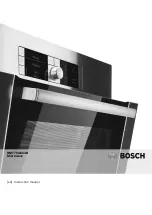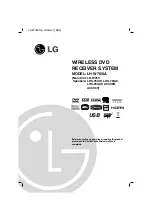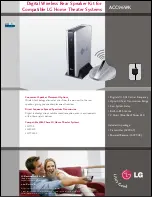
Conneaut Audio Devices
Equitek E-200
The Equitek E-200 combines a
dual electret condenser capsule
design with advanced electronics.
Typical FET (field effect transis-
tor) condenser microphones use
discrete designs. This means they
use individual transistors that
must be carefully matched for
proper characteristics. Even with
careful matching, discrete de-
signs are inherently nonlinear.
Equitek microphones use a dif-
ferent approach. We do not use
any discrete FETs. Instead, we
use advanced high speed
OpAmps (Operational Amplifi-
ers). These OpAmps are indi-
vidually laser trimmed for opti-
mum performance and have very
high gain. This allows a large
amount of negative feedback to
be used to significantly reduce
any non-linearity. During tran-
sients, these OpAmps may re-
quire more current than typical
phantom power supplies can de-
liver. The extra current demands
are accommodated by our unique
power supply design. Instead of
using phantom power to operate
the microphone, we use it to
charge a pair of rechargeable
NiCad batteries. This system cre-
ates a huge current reserve for
the microphone's electronics, yet
there is no maintenance involved
because the microphone auto-
matically keeps the batteries
charged during use. The use of
OpAmps is not the only unique
feature of Equitek microphones.
For example, we also employ
servo circuitry to minimize dc
offset and eliminate interstage
coupling capacitors. The bottom
line is we believe you will find the
Equitek E-200 to have a remark-
ably open and clean sound that
will enhance any project.
Bob Eaton
Senior Microphone Engineer
Made with pride in Conneaut,
Ohio U.S.A.
Description
The Equitek
E-200
from Conneaut Audio Devices is a multi-pattern side address microphone designed for recording
and broadcast applications. The implementation of high speed, low noise, low distortion electronics makes the Equitek
E-200
the ideal candidate for the most critical applications.
The Equitek
E-200
incorporates a number of unique features including:
Servoed head amplifiers.
High SPL Capability (148 dB SPL with pad)
Transformerless balanced output circuits.
Internal power reservoir system that can supply ten times the current available from phantom powering alone.
Dual cantilevered capsule shock isolators.
Remote operation without phantom power using internal batteries.
20 dB non capacitive pad
Stainless steel internal pop/EMI filter.
Automatic power shut down circuit.
1 = Microphone Power On
0 = Microphone Power Off (Use this switch
position for fastest charging of batter-
ies.)
Power
Pattern
= Omnidirectional Pattern
= Cardioid Pattern
= Figure 8 Pattern
Pad
Hi-Pass
Left position = Low end roll off below 80
Hz.
Right Position = Flat low end response.
0dB = Full gain (Highest Sensitivity)
-20dB = 20dB Gain reduction (High-
est Clipping Level)
Switch Functions
Getting Started
Although the internal NiCad batteries were charged at the factory, the batteries will gradually self-discharge if the
microphone has been in storage for quite a while. It may be necessary to charge the batteries before initial use. Please see the
section below on powering the Equitek E-200.
Caution!
The high gain and wide bandwidth of the
E-200
microphone will easily overload the inputs of many professional
mixing consoles if adequate precautions are not taken. This is especially true if the mic is going to be used on percussion or
amplified electronic instruments. If you have never used this microphone before, we strongly recommend that you initially
reduce the system gain by doing one or more of the following:
Enable the pad switch on the input of your mixing console.
Start with the input trim control on your mixing console turned down to a low level.
Enable the -20 dB pad switch on the
E-200
microphone.
Powering the Equitek E-200
The Equitek
E-200
is powered by a combination of 48 Volt phantom power and a pair of rechargeable 9 volt NiCad
batteries. This powering arrangement overcomes the inherent current limiting associated with most phantom power supplies.
The batteries are trickle charged by the phantom supply. When needed, the batteries provide the extra current necessary
during high SPL transients. The microphone will not function without the batteries present. The microphone can be used
without phantom power for periods of up to 6 hours provided the batteries are fully charged. Standard 9 volt alkaline batteries
can also be used if extended operation is needed when no phantom power is available. * (Auto power shut off circuit must be
disabled for battery operation without phantom power.) The minimum requirement for the phantom supply is a regulated 48
volts with the capability of supplying at least 8 mA. of current. (Or the CAD EPS-1 high current 24 volt supply.) Supplies that
do not meet this requirement will not allow continuous operation of the microphone. The high quality NiCad batteries used in
the Equitek
E-200
have a higher output voltage than most normal 9 volt NiCad batteries. These batteries require the same care
as any other type of rechargeable battery. Before initial use, the batteries need to be fully charged. Once the batteries have
received this initial charge, they should not need to be charged in this manner again, unless the microphone is unused for a
long time. The batteries can be charged by two different means:
Connect the microphone to a phantom supply and allow the batteries to charge 12 - 14 hours with the mic turned off.
Remove the batteries from the microphone and charge using a standard NiCad battery charger.
* See the section on Auto Power Shut Off. IF USING ALKALINE 9 VOLT BATTERIES, DO NOT APPLY PHAN-
TOM POWER TO THE MICROPHONE! DOING SO COULD CAUSE PERMANENT DAMAGE TO THE MICROPHONE
AND VOID YOUR WARRANTY!
Auto Power Shut Off Configuration
The Equitek
E-200
incorporates a circuit which shuts the microphone off if phantom power is removed. This is done
so that battery power will be conserved if the user forgets to turn the microphone off. If it is desired to operate the microphone
using only the batteries, this feature must be disabled or the microphone will not function. This is easily done by means of a
small movable configuration jumper located inside the microphone. To gain access to the inside of the microphone, remove
the XLR end cap by first removing the two screws. Then, loosen the screw on the back of the microphone and slide off the
microphone housing. The jumper is labeled JP1 and is located next to the battery holder on the side of the card opposite the
XLR connector. The jumper shorts two of three available pins to select the proper mode. From the factory, the two pins
towards the A are shorted to enable the auto shut off circuit. Two disable the circuit, pull off the jumper and replace it so that
the two pins towards the M (For manual mode) are shorted. The microphone can be used with phantom power when it is in
this mode, however you must remember to turn the microphone off when not in use or the batteries will be depleted.
Summary of Contents for E-200
Page 1: ......






















